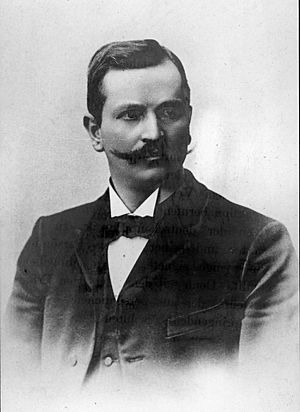Paul Drude facts for kids
Quick facts for kids
Paul Drude
|
|
|---|---|

Paul Karl Ludwig Drude
|
|
| Born | 12 July 1863 Braunschweig, Duchy of Brunswick
|
| Died | 5 July 1906 (aged 42) Berlin, Province of Brandenburg
|
| Alma mater | University of Göttingen |
| Known for | The Drude model Ellipsometry |
| Scientific career | |
| Fields | Physicist |
| Institutions | University of Leipzig Humboldt University of Berlin University of Giessen |
| Doctoral advisor | Woldemar Voigt |
Paul Karl Ludwig Drude (born July 12, 1863 – died July 5, 1906) was a German physicist. He was an expert in optics, which is the study of light. He wrote an important textbook that connected the study of light with Maxwell's ideas about electromagnetism.
Early Life and Education
Paul Drude was born in Braunschweig, Germany. His father was a doctor. Paul first studied mathematics at the University of Göttingen. But he soon changed his main subject to physics.
In 1887, he finished his big research paper, called a dissertation. This paper was about how light bounces off and bends around crystals. His professor, Woldemar Voigt, helped him with this work.
Career and Family
In 1894, Drude became a professor at the University of Leipzig. That same year, he married Emilie Regelsberger. They had four children together.
In 1900, Paul Drude became the editor of Annalen der Physik. This was the most respected physics magazine at that time. From 1901 to 1905, he was a physics professor at Giessen University. Then, in 1905, he became the head of the physics department at the University of Berlin.
In 1906, when he was at the peak of his career, he became a member of the Prussian Academy of Sciences. Paul Drude passed away that same year, leaving behind his wife and four children.
Scientific Work
Paul Drude started his career when new ideas about electromagnetism were becoming popular. These ideas came from James Clerk Maxwell. Around this time, Heinrich Hertz also showed through experiments that light and electricity are connected.
Drude's first experiments were about measuring how light behaves in different solids. He made these measurements very accurately. He then tried to find connections between how light and electricity act in different materials. In 1894, he started using the letter "c" to stand for the speed of light in empty space.
While he was teaching at Leipzig, Drude was asked to write a textbook about optics. He agreed, and the book, Lehrbuch der Optik, was published in 1900. This book brought together the subjects of electricity and optics, which used to be studied separately. Drude called this a huge step forward in science.
In 1900, he also created an important idea called the Drude model. This model helped explain how materials conduct heat, electricity, and how they interact with light. Later, in 1933, other scientists like Arnold Sommerfeld and Hans Bethe improved this model even more.
Honors
- A crater on the Moon is named after him. It is called Drude.
- The Paul-Drude-Institut für Festkörperelektronik in Berlin is also named in his honor.
See also
 In Spanish: Paul Drude para niños
In Spanish: Paul Drude para niños

